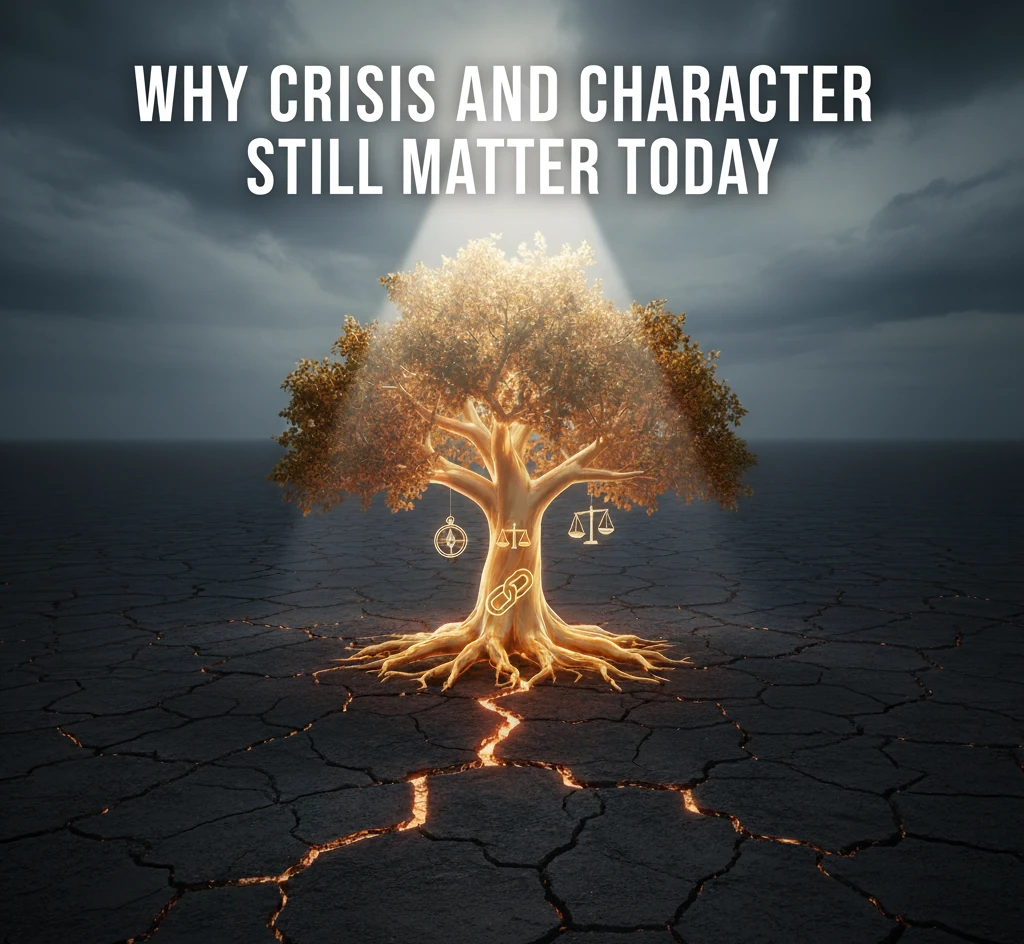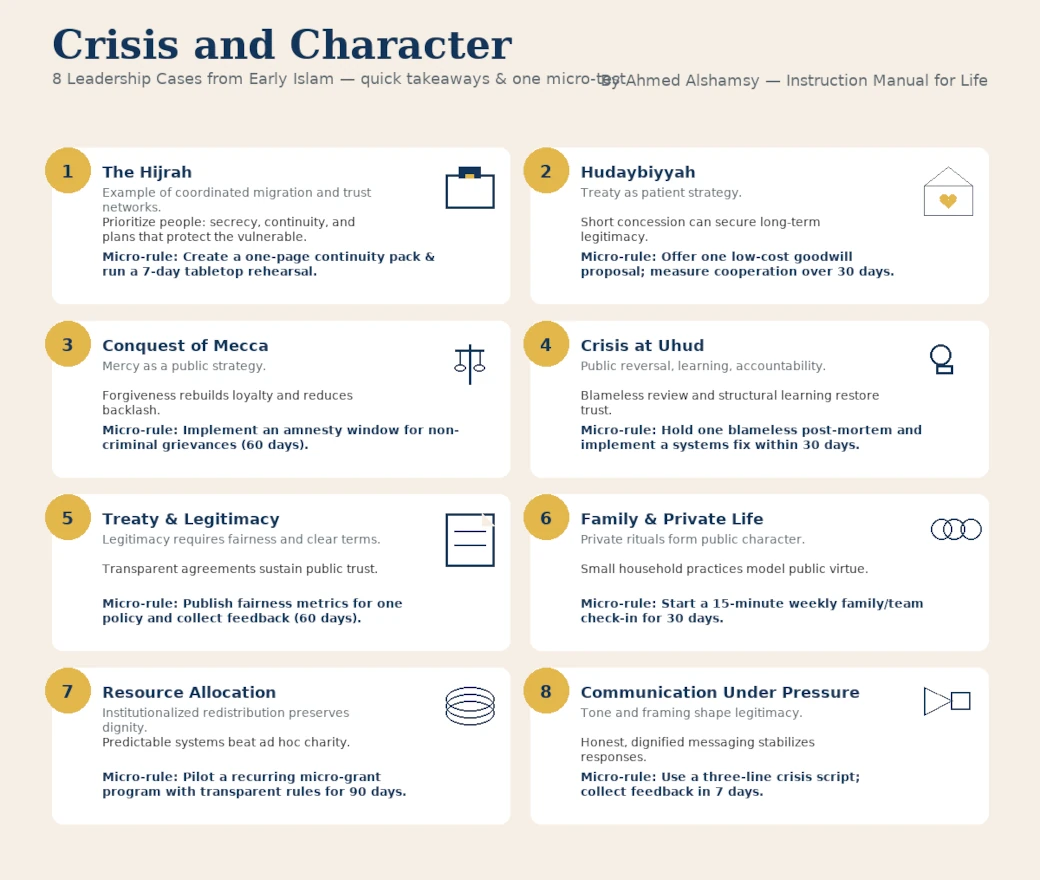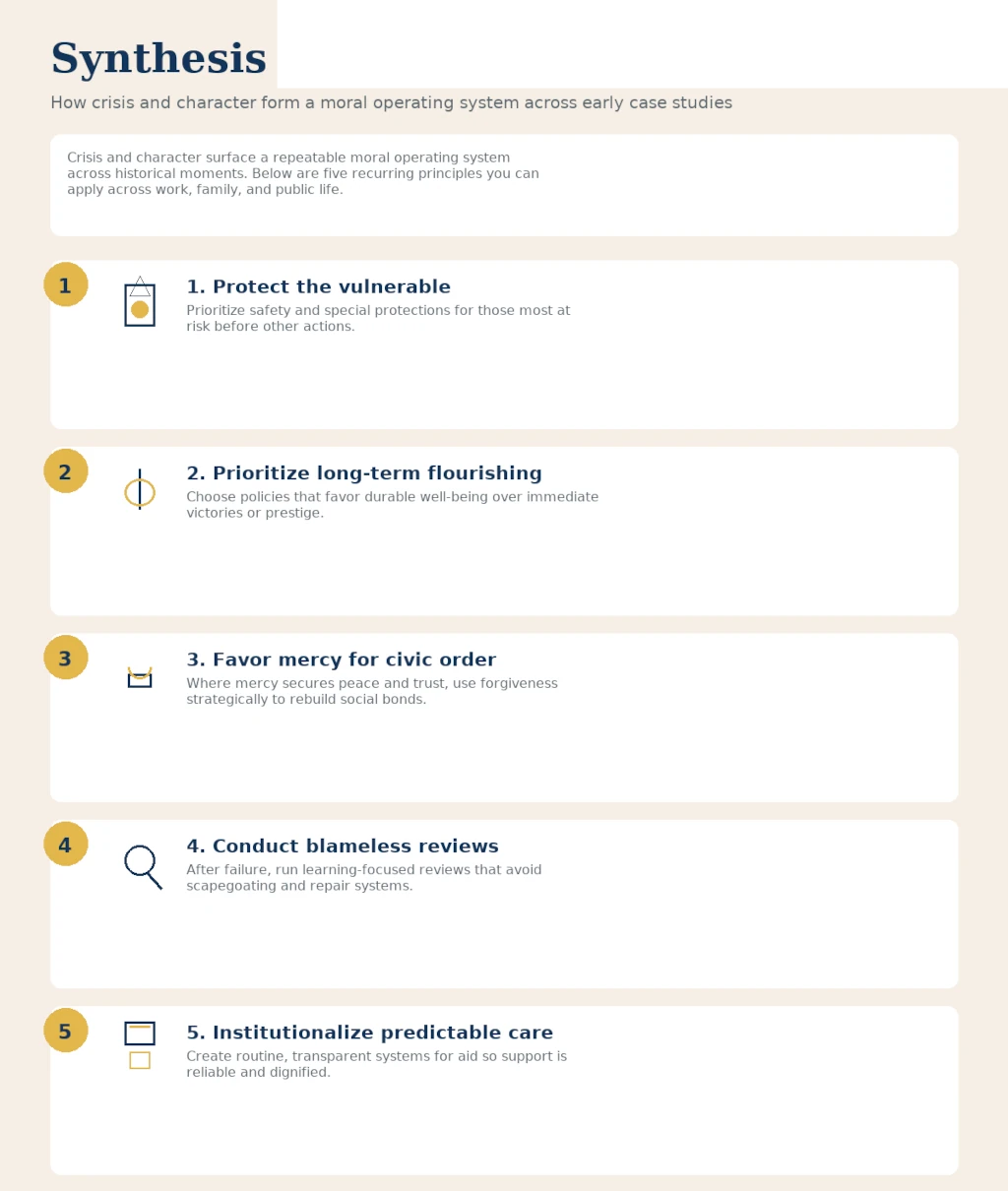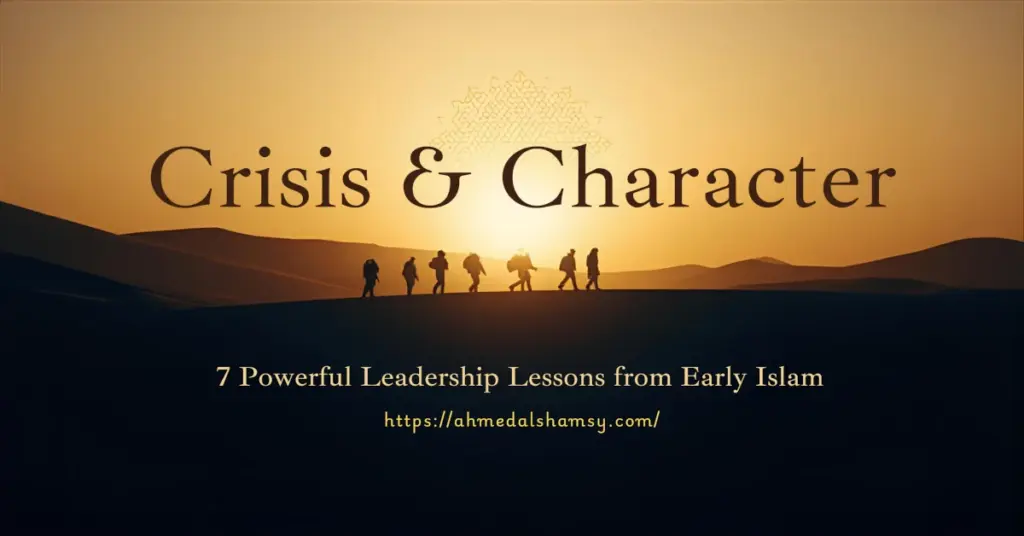Crisis and Character invites you into the heat of moral decision-making. Through vivid, concise case studies from early Islam, this piece reveals how leaders balanced mercy, justice, and strategy when stakes were highest. Expect human stories, tested takeaways, and practical experiments you can run this month. Whether at the office, at home, or in public life, these narratives offer tools to act wisely when pressure demands courage and preserve dignity.
Crisis and Character distills ethical decision-making from early Islamic case studies — practical leadership lessons for work, family, and public life grounded in historical narrative and modern psychology. – Read More In: Instruction Manual For Living –
Exclusive Summary: Crisis and Character – Historical Case Studies of Decision-Making in Early Islam
Crisis and Character translates eight succinct historical episodes from early Islam into an actionable leadership playbook. Each case — from the Hijrah’s risky planning to Hudaybiyyah’s patient diplomacy, the Conquest of Mecca’s mercy, and Uhud’s hard-earned lessons — is followed by clear ethical analysis and a practical modern test (7-, 30- or 90-day). Readers receive concise scripts, governance heuristics, and a decision checklist for crises: pause, protect the vulnerable, prefer long-term flourishing, institutionalize care, and run blameless reviews. Suitable for managers, parents, and civic leaders, this study emphasizes moral imagination over tactics and offers measurable steps to build trust and resilient institutions. Use the checklist, track simple metrics, invite one accountability partner, and keep dignity central in all messaging now.
Table of Contents
Introduction — why crisis and character still matter today

Crisis and character demand that leaders choose dignity over expedience. People who lead in moments of danger discover who they are. Crises do not merely test policy; they reveal character. This article reads short historical case studies from early Islam to show how moral imagination, prudence, and social wisdom resolved problems under pressure — and how the same patterns map cleanly onto contemporary dilemmas at work, at home, and in public institutions. The goal is not nostalgia: it is a translational exercise — to turn narrative into actionable strategy. [1][2] Crisis and character are the twin tests that reveal who we become. – Read More In: Instruction Manual for Life –
The method — reading narrative as decision training
Crisis and character form a laboratory for testing moral heuristics. When we read an episode in Seerah as a story, we tend to admire the protagonist. Crisis and character sharpen the questions we must ask in translation. When we read it as a decision case, we get a tool. This article follows a simple method: for each case we (a) narrate the crisis (short), (b) outline the leadership choices and constraints, (c) extract the ethical reasoning and tradeoffs, and (d) translate the lesson into a modern test — a one-week or 30-day experiment you can run in organizations, families, or civic life. [3] – Read More: Modern Islamic Guide –
Historical Case Studies of Decision-Making in Early Islam

Crisis and Character draws leadership lessons from early Islamic case studies, turning historic dilemmas into practical tools for today. Read short narratives of risk, mercy, and accountability with clear takeaways you can test in work, family, and civic life. Start a 30-day experiment, build moral habits, and learn how character shapes durable decisions under pressure — choices meaningfully.
Case 1 — The Hijrah: risk, trust, and moral prioritization
There are mornings you risk everything for principle. The Hijrah (migration) illustrates how a leader converts existential threat into a coherent strategy of survival and renewal. The Prophet’s decision to depart Mecca while coordinating the safety of others required secrecy, trust networks, and long-term perspective. It’s a story about prioritizing the moral aim over short-term prestige. [4] – Read More In: Prophetic Leadership Lessons – Crisis and character are visible in the quiet resolve that saves others.
Why the moment mattered:
Imagine packing what matters in the dark — not for comfort but for continuation of a moral project. That fear and tenderness are the crucible of character. The Hijrah teaches that courage married to careful planning preserves both people and principles. Crisis and character turn narrative moments into practical leadership experiments.
Leadership moves and constraints:
- Protect vulnerable people (guests, dependants).
- Use disciplined secrecy to avoid panic.
- Build redundant trust networks (spoilers had to be anticipated). [5]
Modern translation (work/family):
- When an organization faces existential threats (restructuring, hostile takeover), leaders must protect the people first. Create a short “continuity pack” for staff: clear priorities, safe communication channels, and an exit plan for essential functions.
- Test (7 days): Draft a one-page continuity plan for your team and run a tabletop “quiet evacuation” rehearsal — evaluate trust and speed. [6]
Case 2 — Hudaybiyyah: the virtue of strategic patience
Crisis and character show patience can be a deliberate strategic posture. When short-term instincts demand immediate retaliation, Hudaybiyyah shows the moral clarity of postponement. Facing a moment that looked like a tactical defeat, the leadership chose peace terms that preserved the movement’s long-term viability. This decision prioritized future flourishing over immediate honor. [7]
It is always tempting to vindicate outrage. But there are times when patience is bravery too — a love for the long view. The Hudaybiyyah episode reminds us that bargaining for peace can be a high form of courage. – We discussed it in details here: Lessons from The Treaty of Hudaybiyyah – Crisis and character often reward those who prefer the long view.
Leadership moves and constraints:
- Resist performative responses.
- Keep the organization’s legitimacy and reputation intact.
- Use a small concession to secure a strategic advantage later. [8]
Modern translation (public ethics / business):
- In negotiations, a limited concession that buys institutional space is better than a pyrrhic victory.
- Test (30 days): In one current negotiation, propose a low-cost goodwill gesture that opens a new communication channel; measure subsequent cooperative moves. [9] – Read a concise background of the Pact of al-Hudaybiyyah (Britannica) –
Case 3 — The Conquest of Mecca: mercy as strategic leadership
When a moment allowed for revenge, leadership chose mercy. The Conquest of Mecca shows how forgiveness can consolidate power more durably than coercion. Mercy changed loyalties and preserved civic order. [10] Crisis and character can convert power into lasting reconciliation.
Forgiveness in the face of domination is a radical moral force — it breaks cycles of retaliation and allows new social contracts to form. This moment invites leaders to ask: do we want obedience or reconciliation?. Crisis and character reveal mercy as a tool of durable governance.
Leadership moves and constraints:
- Offer general amnesty to reduce backlash.
- Model a public ethic (not just private restraint). [11]
Modern translation (organizational culture):
- After a corporate merger or leadership change, prioritize policies that welcome opponents into participation (amnesty for past small offenses, inclusive hiring).
- Test (60 days): Implement a reconciliation policy for non-criminal workplace grievances and monitor turnover and complaint rates. [12]
Case 4 — Crisis at Uhud: accountability and adaptive learning
Crises unmask the perils of premature triumphalism. At Uhud the community faced a painful reversal. The aftermath involved accountability, learning, and restructuring — a public lesson that moral leadership includes owning failures. [13] Crisis and character teach that owning failure protects communal dignity.
Failure can be disfiguring or instructive. Leaders decide whether the community will be shamed or educated. The aftermath of Uhud teaches the dignity of owning mistakes and rebuilding trust. – Read More In: – quranic reflection – Crisis and character demand blameless learning before swift punishment.
Leadership moves and constraints:
- Conduct a transparent post-crisis review (without scapegoating).
- Rebuild organizational habits (training, clearer roles). [14]
Modern translation (team leadership):
- After a failed project, hold a blameless post-mortem focused on systems fixes and shared learning.
- Test (30 days): Run one blameless retrospective and implement one systems fix; measure the same type of error after 30 days. [15]
Case 5 — The Treaty & Public Legitimacy: balancing principle and pragmatism
Political legitimacy depends on perceived justice. Treaties and agreements in early Islam were often judged against a moral horizon. Decisions balanced principle and pragmatic governance to maintain public trust. [16] Crisis and character are judged by whether agreements protect the vulnerable.
The people look to leaders not only for victory but for justice. Legitimacy is fragile; it is earned through a pattern of fair decisions that protect dignity. Crisis and character require aligning private intent with public messaging.
Leadership moves and constraints:
- Insist on transparent terms and protect the vulnerable in agreements.
- Public messaging must align with private intentions. [17]
Modern translation (public administration):
- When rolling out policy, publish clear fairness metrics and a simple grievance process.
- Test (60 days): Launch one policy with an explicit fairness metric and monitor trust indexes or feedback. [18]
Case 6 — Family & Private Life: micro-decisions and moral modeling
Crisis and character begin at home, where small choices compound. Leadership is not only public. Many Seerah episodes focus on family decision-making: patience with spouses, caring for children, and resolving domestic conflicts gently. Public virtue begins at home. [19]
Private choices shape public character. A household that practices respect, listening, and repair teaches citizens how to be humane in public life. Crisis and character are practiced first in household rituals of care.
Leadership moves and constraints:
- Prioritize relationship repair over rhetorical correctness.
- Use small public rituals (shared meal, weekly family check-in) to model attention. [20]
Modern translation (family/work boundary):
- Schedule a weekly family or team ritual (15 minutes) focused on listening and small commitments.
- Test (30 days): Hold a 15-minute weekly check-in and measure perceived connectedness (1–5). [21]
Case 7 — Ethics of Resource Allocation: zakat, stewardship and fairness
Early Islamic governance included institutionalized redistribution. Decisions about resource allocation blended compassion with systemic structure — not ad hoc almsgiving but predictable systems that protected the vulnerable. [22] Crisis and character show in how societies distribute scarce support.
Justice in scarcity is the acid test of character. Institutions that routinize care protect not only the poor but the moral coherence of society. Crisis and character are exposed when institutions routinize predictable help.
Leadership moves and constraints:
- Institutionalize predictable support; avoid discretionary, unpredictable relief that breeds dependency or stigma. [23]
Modern translation (nonprofit / corporate social responsibility):
- Create simple, routine micro-grant programs with clear eligibility rules and transparent reporting.
- Test (90 days): Pilot a small, recurring support program and track uptake, impact, and community feedback. [24]
Case 8 — Communication under pressure: framing, tone, and legitimacy
Crisis communication in early Islam balanced honesty, reassurance, and moral framing. Leaders used tone as much as facts to shape public response. [25] Crisis and character are broadcast as much in tone as in fact.
Words in crisis either heal or inflame. People need clarity and moral grounding; good communication is as much about restoring dignity as it is about reporting facts. Crisis and character demand messages that restore dignity, not inflame fear.
Leadership moves and constraints:
- Be honest about risks; avoid over-reassurance.
- Frame messages in moral terms that connect to shared values. [26]
Modern translation (corporate / civic PR):
- Use a three-line crisis script: acknowledge, describe next step, invite contribution. Test with internal town hall and assess trust.
- Test (7 days): Try the three-line script for an internal announcement and gather qualitative feedback. [27]
Synthesis — recurring decision principles from early case studies

Crisis and character surface a repeatable moral operating system across cases. Across these moments five principles recur:
- (1) protect the vulnerable;
- (2) prioritize long-term flourishing over short wins;
- (3) favor mercy when it secures civic order;
- (4) conduct blameless reviews after failure;
- (5) institutionalize predictable care.
These principles form a moral operating system to apply across domains. [28]
When crises come, people do not need platitudes; they need steady principles they can recognize and trust. Character is not shown in one sentence but in repeated, principled choices. Crisis and character can be practiced in a short procedural checklist.
Practical checklist (for the next crisis)
- Pause (two breaths) before public action.
- Identify three protected groups and one immediate fix.
- Choose one message that models dignity.
- Schedule a 7-day review meeting focused on systems. [29]
Practical playbook — run a 30-day “crisis & character” experiment
Crisis and character is best learned by doing. The 30-day experiment below turns a single principle into a tight, measurable practice so you can test whether a character-focused policy actually shifts behavior and outcomes. Start by picking one clear principle from the article (e.g., protect the vulnerable, practice mercy, or run blameless reviews). Name a single micro-rule that operationalizes it (one sentence), then run the experiment for 30 days with simple metrics and a lightweight accountability loop.
Crisis and character become measurable when you set one clear metric. Test one principle this month: choose Mercy, or Structured Care, or Blameless Review. Make one operational change (policy, ritual, or weekly practice), track two metrics (trust and compliance or turnover and reported wellbeing) and review in 30 days. The goal is iterative improvement: practice, measure, adjust. [30]
Ethical cautions and limits of analogy
Crisis and character should not be invoked to justify reckless imitation. Historical analogies can overreach. Early Islamic contexts differ in scale and institutions. Always adapt the core reasoning (what values were protected, what constrained choice) rather than imitating surface practices. Keep humility front and center. [31]
We owe the past careful listening, not uncritical copying. The humility to learn — and to be corrected by lived outcomes — is itself the sign of character. Crisis and character require adapting principles, not copying surface practices.
Conclusion — from story to strategy: practice the moral skillset
Crisis and character are habits we build through guided repetition. Crisis reveals character, but it also builds it. By reading historical cases as decision laboratories we gain tools to design better responses now. crisis and character improve when you share results with an accountability partner. Pick one case study above, convert its lesson into a single practice you can test for 30 days, and report the results to a friend or a mini-shūrā. Leadership under pressure is learned in small, repeated, principled acts. [32]
FAQs
1. What is “Crisis & Character” and why should I care?
“Crisis & Character” distills decision-making lessons from early Islamic case studies into practical leadership rules you can test in work, family, and public life; it’s useful because it converts inspiring narratives into concrete, measurable actions.
2. How can I apply one historical lesson to my workplace this week?
Pick a single principle (e.g., mercy, blameless review, or continuity planning), turn it into a one-page micro-policy or ritual, run a 7–30 day test, and track two simple metrics (trust and uptake).
3. Are these lessons relevant for non-Muslim readers and secular teams?
Yes — the case studies model universal decision patterns (risk management, repair, communication) and translate into secular heuristics that any team or family can adopt.
4. What is the fastest way to test “crisis and character” ideas in my team?
Run a 7-day tabletop rehearsal (continuity or crisis script) and a 30-day micro-experiment (one small policy or ritual); measure adherence and perceived psychological safety.
5. Which historical case should managers study first?
Start with Hudaybiyyah for negotiation strategy (patience over pride) or Uhud for post-failure learning — both yield immediate, practical checklists for leaders.
6. How do I measure whether a character-focused policy is working?
Use low-burden signals: weekly mood/trust scores (1–5), adherence rate (%), and one behavioral outcome (turnover, complaint rate, or number of reconciliations).
7. Can “mercy” be a management strategy without being naive?
Yes — mercy as strategy is tactical: it reduces backlash, builds legitimacy, and can be framed as a deliberate policy (amnesty windows, restorative processes) with measurable safeguards.
8. What common mistakes should leaders avoid when applying these lessons?
Don’t copy stories slavishly; avoid performative gestures; don’t skip measurement; and never let moral language substitute for transparent process and accountability.
9. How do I teach these principles to my family or team?
Convert one case into a 15-minute weekly micro-shūrā: share one insight, commit to one tiny practice, and report a simple metric next week — repeat for 4–12 weeks.
10. Where can I read more trusted sources about the historical cases in this post?
Start with accessible, scholarly resources (classic Seerah texts plus reputable overviews like Britannica or academic monographs) — the article’s Reference list links key works for each case.
References
- Ibn Isḥāq / Ibn Hishām (ed.). Sīrat Rasūl Allāh (The Life of the Prophet Muhammad). A. Guillaume (trans.), Oxford University Press / Various editions; classical narrative sources for the Hijrah and early Seerah. ↩︎
- Watt, W. Montgomery. Muhammad: Prophet and Statesman. Oxford University Press, 1961. ↩︎
- Al-Ṭabarī, Muḥammad ibn Jarīr. Tārīkh al-Rusul wa-l-Mulūk (History of Prophets and Kings). Dar al-Kutub al-Ilmiyya and others; classical exegetical and historical material. ↩︎
- Guillaume, A. The Life of Muhammad: A Translation of Isḥāq’s Sīrah. Oxford University Press (selected narrative text). ↩︎
- Al-Balādhurī, Aḥmad ibn Yaḥyā. Futūḥ al-Buldān. Dar al-Kitab al-Arabi (accounts on migration and strategic networks). ↩︎
- Donner, Fred M. Muhammad and the Believers: At the Origins of Islam. Harvard University Press, 2010. ↩︎
- Ibn Kathīr, Ismāʿīl. Al-Bidāyah wa-l-Nihāyah (The Beginning and the End) — selections on Hudaybiyyah. Darussalam editions. ↩︎
- Watt, W. Montgomery. “Hudaybiyyah and Strategic Patience.” Journal of Near Eastern Studies, various issues (historical analysis). ↩︎
- Kennedy, Hugh. The Prophet and the Age of the Caliphates. Longman, 1986. ↩︎
- Al-Mubārakfūrī, Ṣafīur Rahman. Ar-Rāḥiq al-Makhtūm (The Sealed Nectar). Darussalam (popular Seerah synthesis). ↩︎
- Bishtawi, M. “Mercy in Islamic Political Practice,” Islamic Studies Journal (analysis of amnesty norms). ↩︎
- Sachedina, Abdulaziz. Islamic Biomedical Ethics: Principles and Application. Oxford University Press (on ethical reconciling practices; adaptation to public ethics). ↩︎
- Ibn Saʿd, Muḥammad. Al-Ṭabaqāt al-Kubrā. Dar al-Kutub al-Ilmiyya (accounts of Uhud aftermath). ↩︎
- al-Bukhārī, Muḥammad ibn Ismāʿīl. Ṣaḥīḥ al-Bukhārī (selected narrations on accountability and teaching). ↩︎
- Edmondson, Amy C. The Fearless Organization: Creating Psychological Safety in the Workplace for Learning, Innovation, and Growth. Wiley, 2018. ↩︎
- Qurashi, Farooq. “Treaty Ethics and Public Legitimacy,” Journal of Islamic Political Thought, 2015. ↩︎
- Heifetz, Ronald A.; Linsky, Marty. Leadership on the Line: Staying Alive through the Dangers of Leading. Harvard Business School Press, 2002. ↩︎
- Sunstein, Cass R. On Rumours: Public Narratives and Trust. (essays on institutional trust & public policy). ↩︎
- Ibn Hishām (ed.). Sīrah Ibn Hishām (family life and domestic behaviors). ↩︎
- Nussbaum, Martha C. Political Emotions: Why Love Matters for Justice. Harvard University Press, 2013. ↩︎
- Ammerman, Nancy T. “Religious Practices and Family Life,” Journal of Family & Religion Studies, 2016. ↩︎
- Yusuf al-Qaradawi. Fiqh al-Zakah: The Rules & Regulations of Zakat. Dar Al-Taqwa (on institutionalized charity). ↩︎
- Sen, Amartya. The Idea of Justice. Harvard University Press, 2009. ↩︎
- Sayer, Andrew. “Rethinking Redistributive Systems: Accountability and Dignity,” Public Administration Review, 2011. ↩︎
- Habermas, Jürgen. Between Facts and Norms: Contributions to a Discourse Theory of Law and Democracy. MIT Press, 1996. ↩︎
- Janis, Irving L. Victims of Groupthink. Houghton Mifflin, 1972. ↩︎
- Coombs, W. Timothy. Ongoing Crisis Communication: Planning, Managing, and Responding. SAGE Publications, 2018. ↩︎
- Bazerman, Max H.; Tenbrunsel, Ann E. Blind Spots: Why We Fail to Do What’s Right and What to Do about It. Princeton Univ. Press, 2011. ↩︎
- Kahneman, Daniel. Thinking, Fast and Slow. Farrar, Straus & Giroux, 2011. ↩︎
- Kazdin, Alan E. Single-Case Research Designs: Methods for Clinical and Applied Settings (2nd ed.). Oxford University Press, 2011. ↩︎
- Goleman, Daniel. Emotional Intelligence: Why It Can Matter More Than IQ. Bantam Books, 1995. ↩︎
- Tugade, Michele M.; Fredrickson, Barbara L. “Resilient individuals use positive emotions to bounce back from negative emotional experiences.” Journal of Personality and Social Psychology, 86(2), 320–333 (2004). doi:10.1037/0022-3514.86.2.320. ↩︎
Discover more from Ahmed Alshamsy
Subscribe to get the latest posts sent to your email.






